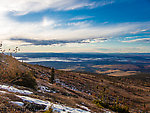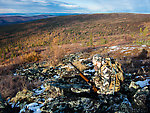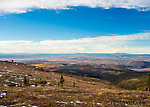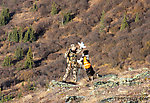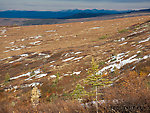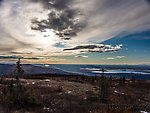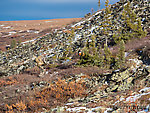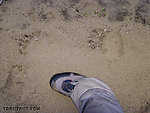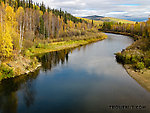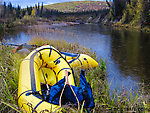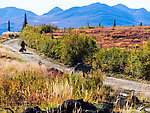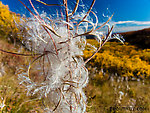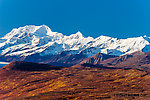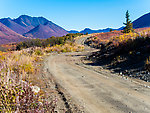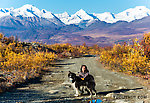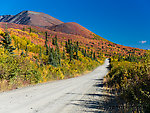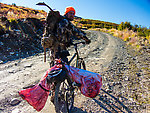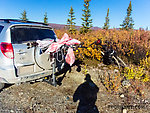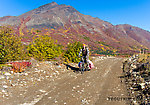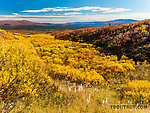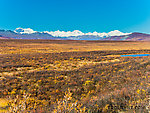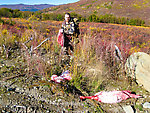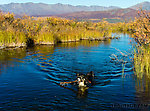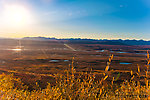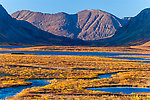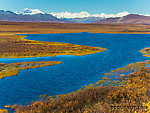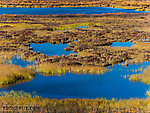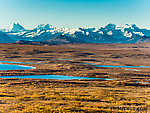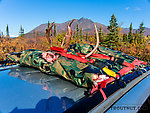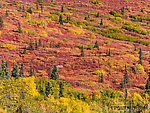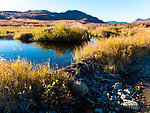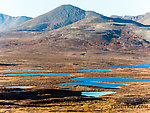Blog & Latest Updates
Fly Fishing Articles
Insects by Common Name


Latest updates, page 35
Afternoon bird hunt
Winter's coming on quickly in Fairbanks, so we took advantage of one nice afternoon to drive up to a well-known bird-hunting spot, hike around, and maybe find some dinner. There weren't many birds, but I managed to get one rock ptarmigan.
Photos by Troutnut from Miscellaneous Alaska in Alaska
First time in a packraft in the lower Chatanika, trying for sheefish
Yesterday afternoon a friend and I floated ten miles of the Chatanika River near Fairbanks, from a spot near the Steese Highway to the Elliott Highway bridge.
Our mutual goal was to try to catch a sheefish. Sheefish are very large piscivorous (Piscivorous: Anything which eats primarily fish is a piscivore.) whitefish, present in very low numbers along the Alaska road system in the Yukon drainage. Most people who really want to catch sheefish have to expensively fly out to the wilderness of northwest Alaska, but the Chatanika River river near Fairbanks is well-known to have a very small spawning run (about 100 fish) during which one has a better-than-usual chance (but still a very long shot) of hooking up with a sheefish. We both thought it would be fun to catch (or even see) the elusive "tarpon of the north," but we had no luck. Didn't even see one.
Another goal for me on this trip was to try packrafting for the first time in some easy Class I water. Packrafts are tiny, tough, ultra-light (often less than 5 pounds) boats used for backpacking into remote locations and floating out on a river (or paddling around a lake). I've been thinking about getting one for remote backcountry fishing and hunting, so I was happy to try it out with a borrowed raft. This wasn't "real" packrafting because we didn't have to pack the boats more than a hundred yards on this road-to-road float, but I got a good feel for the boat and was impressed with its handling and portability.
Have any of you used packrafts for fly fishing (or hunting)? What did you think?
Our mutual goal was to try to catch a sheefish. Sheefish are very large piscivorous (Piscivorous: Anything which eats primarily fish is a piscivore.) whitefish, present in very low numbers along the Alaska road system in the Yukon drainage. Most people who really want to catch sheefish have to expensively fly out to the wilderness of northwest Alaska, but the Chatanika River river near Fairbanks is well-known to have a very small spawning run (about 100 fish) during which one has a better-than-usual chance (but still a very long shot) of hooking up with a sheefish. We both thought it would be fun to catch (or even see) the elusive "tarpon of the north," but we had no luck. Didn't even see one.
Another goal for me on this trip was to try packrafting for the first time in some easy Class I water. Packrafts are tiny, tough, ultra-light (often less than 5 pounds) boats used for backpacking into remote locations and floating out on a river (or paddling around a lake). I've been thinking about getting one for remote backcountry fishing and hunting, so I was happy to try it out with a borrowed raft. This wasn't "real" packrafting because we didn't have to pack the boats more than a hundred yards on this road-to-road float, but I got a good feel for the boat and was impressed with its handling and portability.
Have any of you used packrafts for fly fishing (or hunting)? What did you think?
Photos by Troutnut from the Chatanika River in Alaska
Updates from September 27, 2013
Closeup insects by Entoman from the St. Joe River in Idaho
Female Dicosmoecus atripes (October Caddis) Caddisfly Adult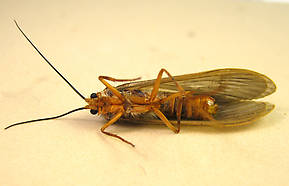 View 6 PicturesThis specimen is 26 mm.
View 6 PicturesThis specimen is 26 mm.
- Entoman
 View 6 PicturesThis specimen is 26 mm.
View 6 PicturesThis specimen is 26 mm.- Entoman
Collected September 27, 2013 from the St. Joe River in Idaho
Added to Troutnut.com by Entoman on September 29, 2013
Added to Troutnut.com by Entoman on September 29, 2013
Updates from September 26, 2013
Denali Highway, day 2
We slept in Sunday morning and biked up to get the remaining meat around noon. The weather and ride were as nice as the previous day's, as was the rest of the beautiful but uneventful drive back across the Denali Highway to Paxson. We saw no other caribou and many dozen hunters, underscoring just how lucky I'd been to find a bull, even such a small one.
We reached the eastern side of the highway as the sun set and the moon rose over Mount Sanford, a majestic shield volcano 90 miles to the southeast in the Wrangells. That range is occasionally visible from high points on the eastern Denali Highway, but I'd never seen it so clearly before. Just another one-of-a-kind treat from the most scenic highway on Earth.
We reached the eastern side of the highway as the sun set and the moon rose over Mount Sanford, a majestic shield volcano 90 miles to the southeast in the Wrangells. That range is occasionally visible from high points on the eastern Denali Highway, but I'd never seen it so clearly before. Just another one-of-a-kind treat from the most scenic highway on Earth.
Photos by Troutnut from Clearwater Mountains, Denali Highway, and Miscellaneous Alaska in Alaska
Closeup insects by Entoman from Mystery Creek #178 in Idaho
Female Psychoglypha alascensis (Snow Sedge) Caddisfly Adult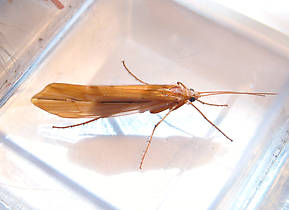 View 3 PicturesThis specimen was 22 mm.
View 3 PicturesThis specimen was 22 mm.
 View 3 PicturesThis specimen was 22 mm.
View 3 PicturesThis specimen was 22 mm.Collected September 15, 2013 from Mystery Creek #178 in Idaho
Added to Troutnut.com by Entoman on September 23, 2013
Added to Troutnut.com by Entoman on September 23, 2013
Female Timpanoga hecuba (Great Red Quill) Mayfly Dun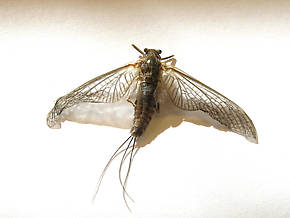 View 3 PicturesThis specimen is 14 mm. Technically this is the subspecies (Subspecies: Entomologists sometimes further divide a species into distinct groups called subspecies, which have two lower-case words on the end of their scientific name instead of one. The latter is the sub-species name. For example, Maccaffertium mexicanum mexicanum and Maccaffertium mexicanum integrum are two different subspecies of Maccaffertium mexicanum.) T. h. hecuba. The Cascades, Sierras and further West is where the other subspecies (Subspecies: Entomologists sometimes further divide a species into distinct groups called subspecies, which have two lower-case words on the end of their scientific name instead of one. The latter is the sub-species name. For example, Maccaffertium mexicanum mexicanum and Maccaffertium mexicanum integrum are two different subspecies of Maccaffertium mexicanum.), T. h. pacifica is found. The Great Basin seems to have formed a barrier preventing any overlap in their distribution.
View 3 PicturesThis specimen is 14 mm. Technically this is the subspecies (Subspecies: Entomologists sometimes further divide a species into distinct groups called subspecies, which have two lower-case words on the end of their scientific name instead of one. The latter is the sub-species name. For example, Maccaffertium mexicanum mexicanum and Maccaffertium mexicanum integrum are two different subspecies of Maccaffertium mexicanum.) T. h. hecuba. The Cascades, Sierras and further West is where the other subspecies (Subspecies: Entomologists sometimes further divide a species into distinct groups called subspecies, which have two lower-case words on the end of their scientific name instead of one. The latter is the sub-species name. For example, Maccaffertium mexicanum mexicanum and Maccaffertium mexicanum integrum are two different subspecies of Maccaffertium mexicanum.), T. h. pacifica is found. The Great Basin seems to have formed a barrier preventing any overlap in their distribution.
 View 3 PicturesThis specimen is 14 mm. Technically this is the subspecies (Subspecies: Entomologists sometimes further divide a species into distinct groups called subspecies, which have two lower-case words on the end of their scientific name instead of one. The latter is the sub-species name. For example, Maccaffertium mexicanum mexicanum and Maccaffertium mexicanum integrum are two different subspecies of Maccaffertium mexicanum.) T. h. hecuba. The Cascades, Sierras and further West is where the other subspecies (Subspecies: Entomologists sometimes further divide a species into distinct groups called subspecies, which have two lower-case words on the end of their scientific name instead of one. The latter is the sub-species name. For example, Maccaffertium mexicanum mexicanum and Maccaffertium mexicanum integrum are two different subspecies of Maccaffertium mexicanum.), T. h. pacifica is found. The Great Basin seems to have formed a barrier preventing any overlap in their distribution.
View 3 PicturesThis specimen is 14 mm. Technically this is the subspecies (Subspecies: Entomologists sometimes further divide a species into distinct groups called subspecies, which have two lower-case words on the end of their scientific name instead of one. The latter is the sub-species name. For example, Maccaffertium mexicanum mexicanum and Maccaffertium mexicanum integrum are two different subspecies of Maccaffertium mexicanum.) T. h. hecuba. The Cascades, Sierras and further West is where the other subspecies (Subspecies: Entomologists sometimes further divide a species into distinct groups called subspecies, which have two lower-case words on the end of their scientific name instead of one. The latter is the sub-species name. For example, Maccaffertium mexicanum mexicanum and Maccaffertium mexicanum integrum are two different subspecies of Maccaffertium mexicanum.), T. h. pacifica is found. The Great Basin seems to have formed a barrier preventing any overlap in their distribution.Collected September 15, 2013 from Mystery Creek #178 in Idaho
Added to Troutnut.com by Entoman on September 23, 2013
Added to Troutnut.com by Entoman on September 23, 2013
Top 10 Fly Hatches
Top Gift Shop Designs
Eat mayflies.
Top Insect Specimens
Miscellaneous Sites
Troutnut.com is copyright © 2004-2024 Jason
Neuswanger (email Jason). See my FAQ for information about use of my images.
 privacy policy
privacy policy

